Sterilization Wrap System
Turbett; Robert E.
U.S. patent application number 16/040058 was filed with the patent office on 2019-01-24 for sterilization wrap system. The applicant listed for this patent is Turbett Surgical, LLC. Invention is credited to Robert E. Turbett.
| Application Number | 20190021806 16/040058 |
| Document ID | / |
| Family ID | 65014463 |
| Filed Date | 2019-01-24 |

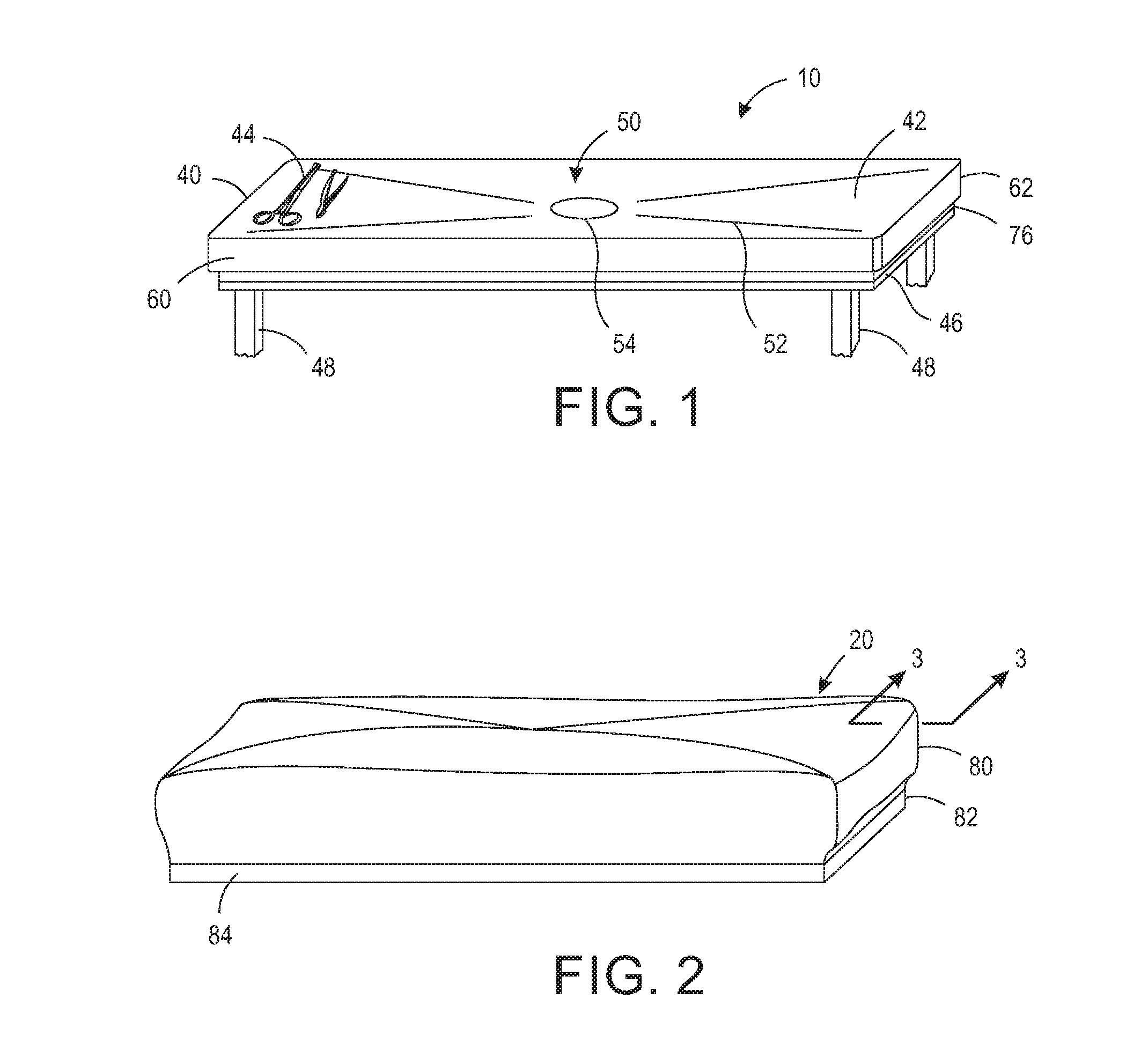
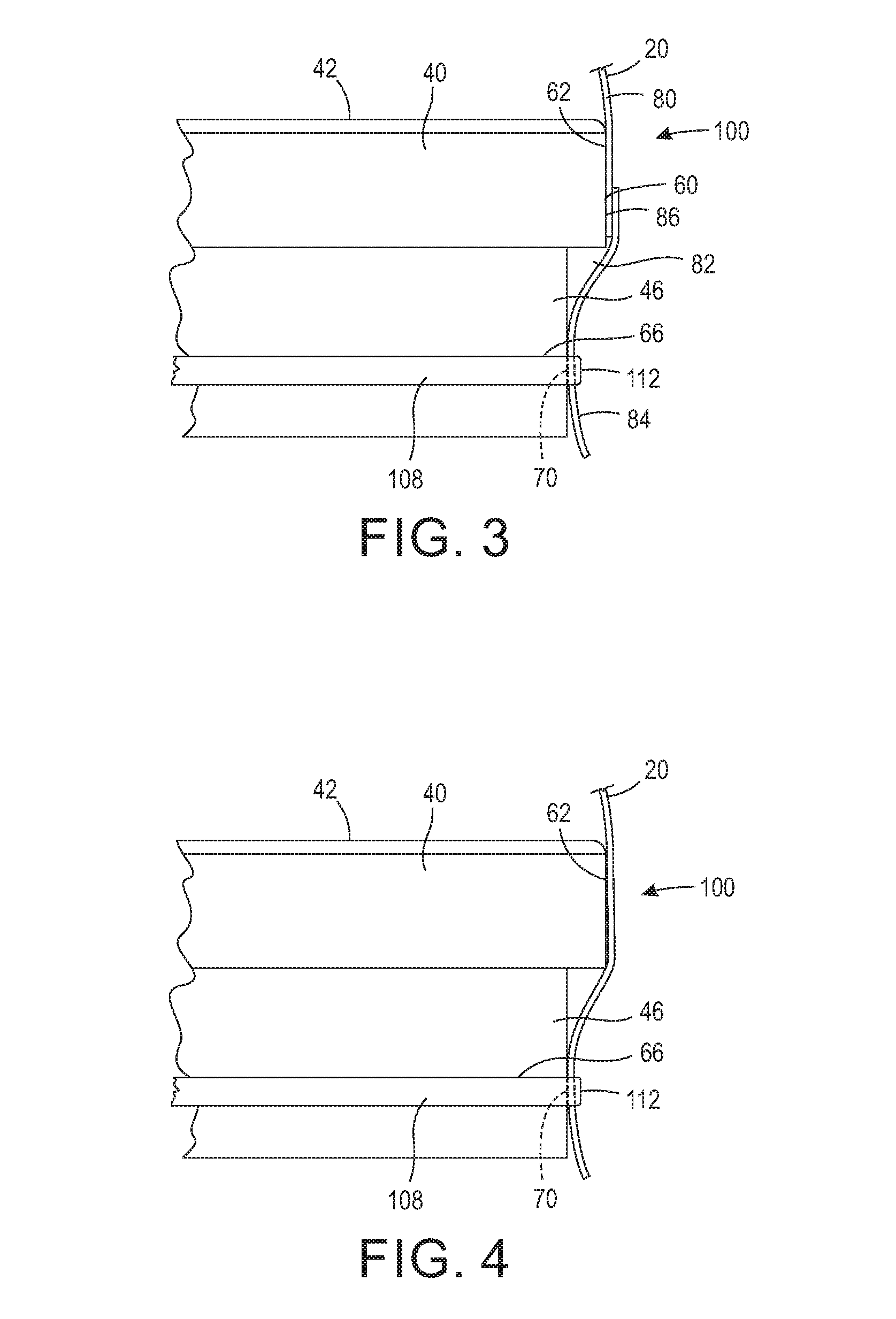
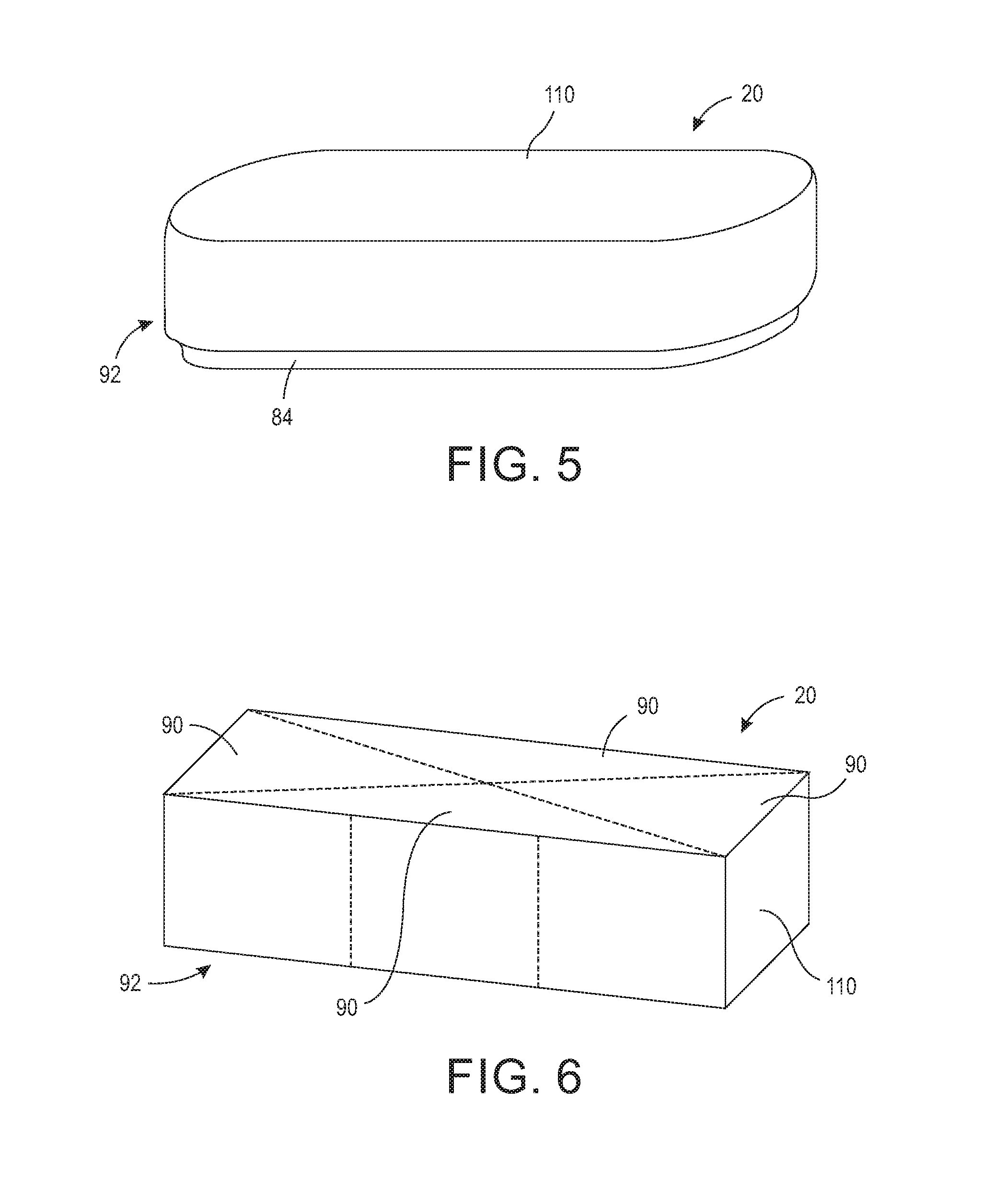
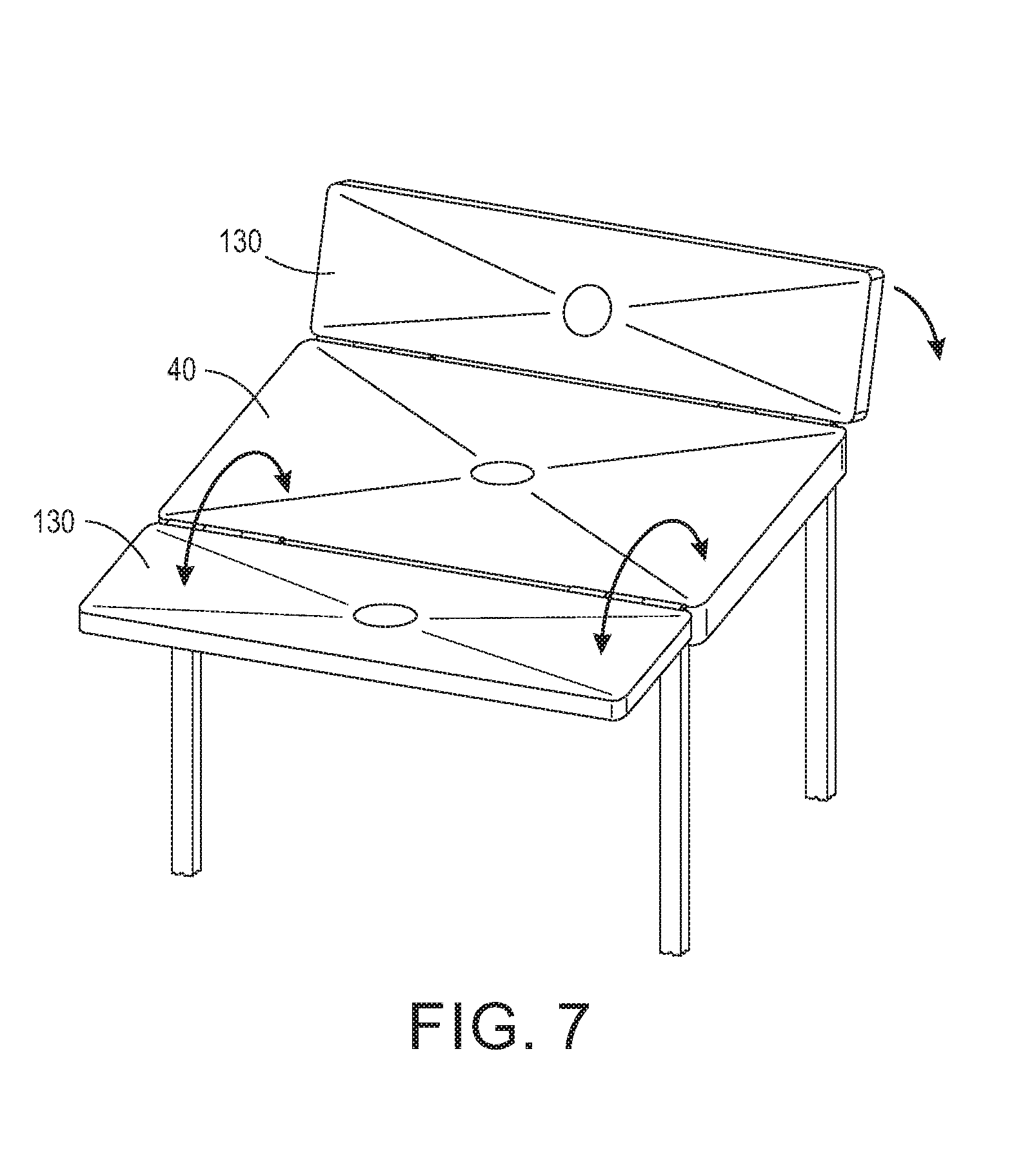
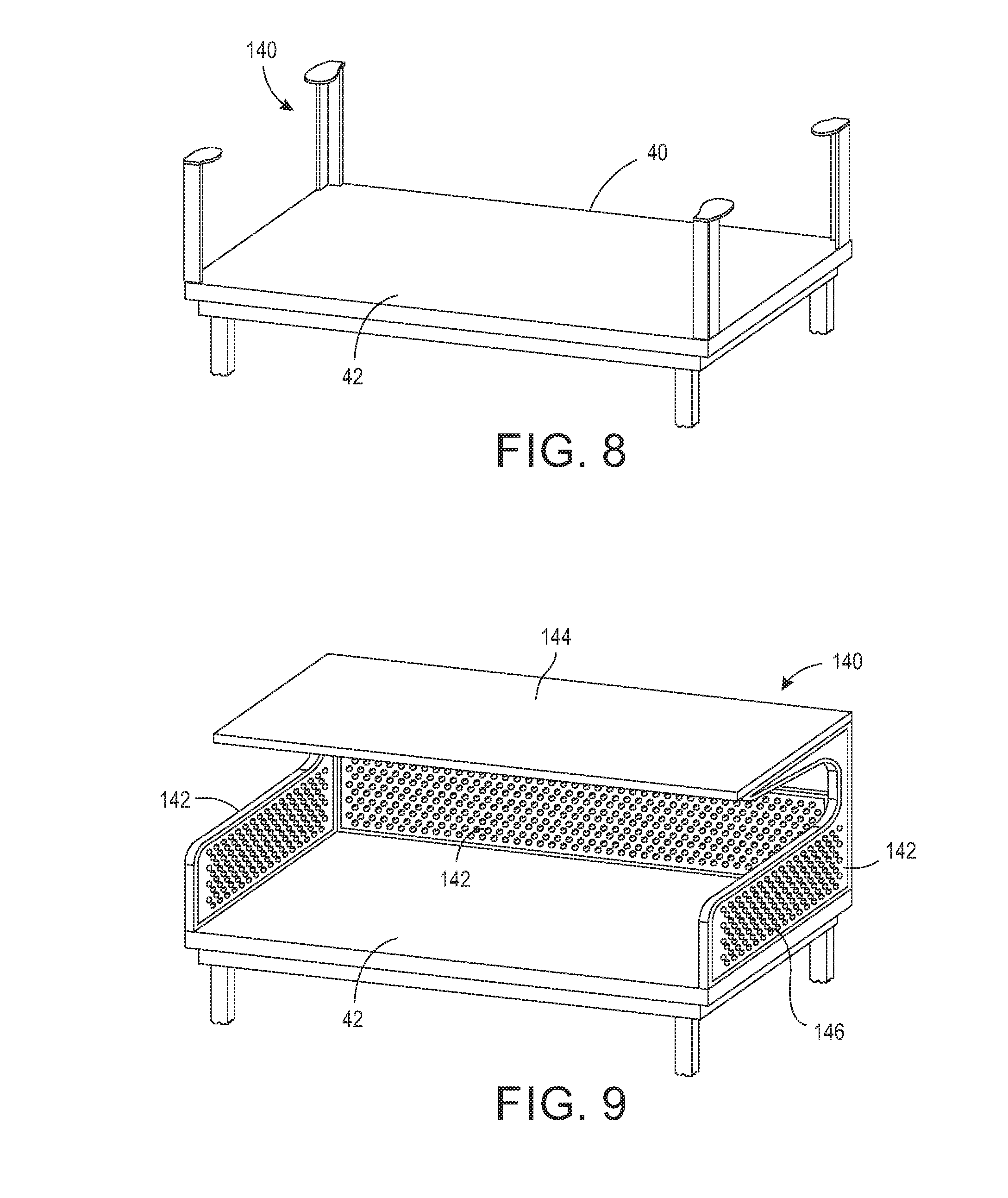

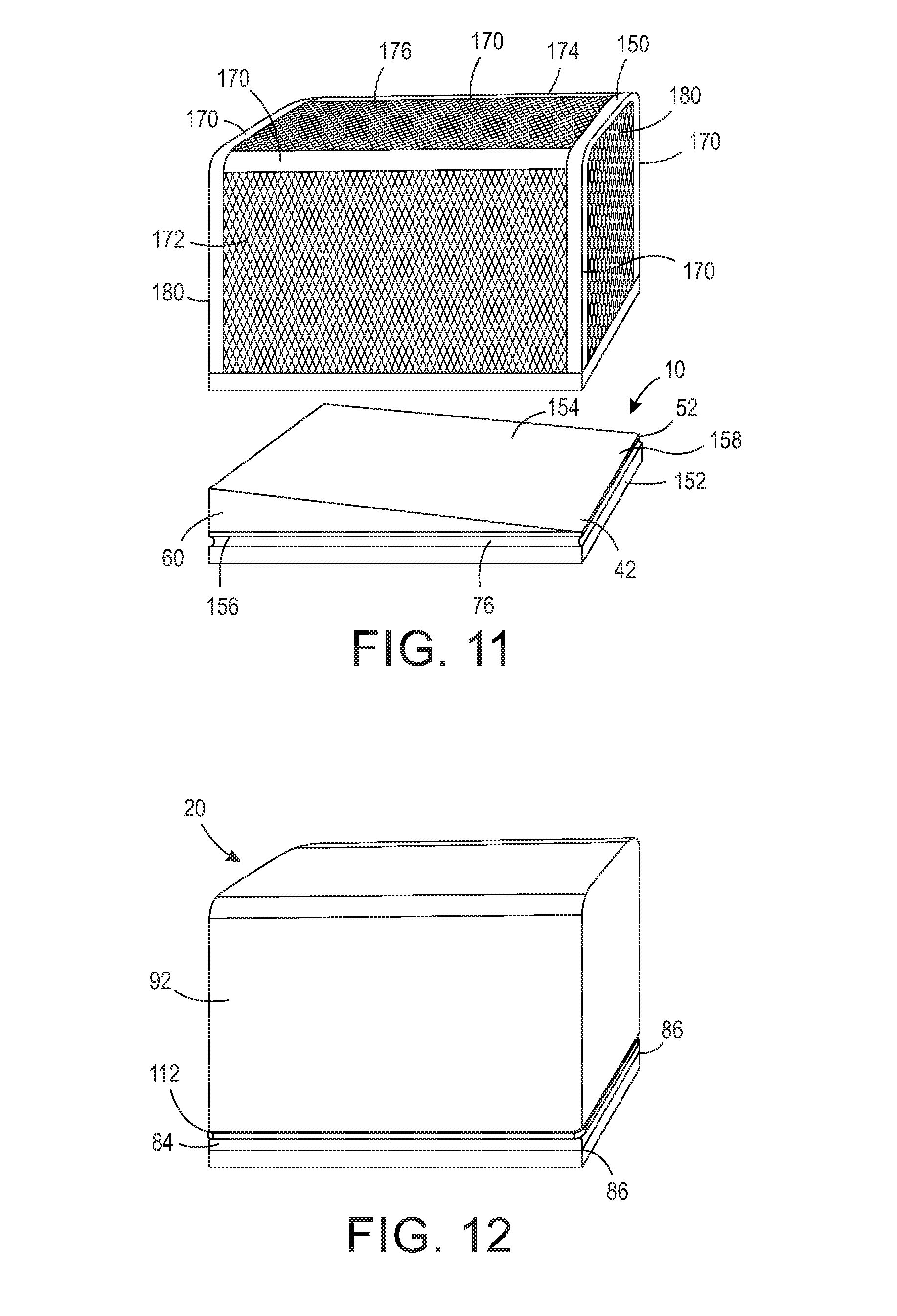


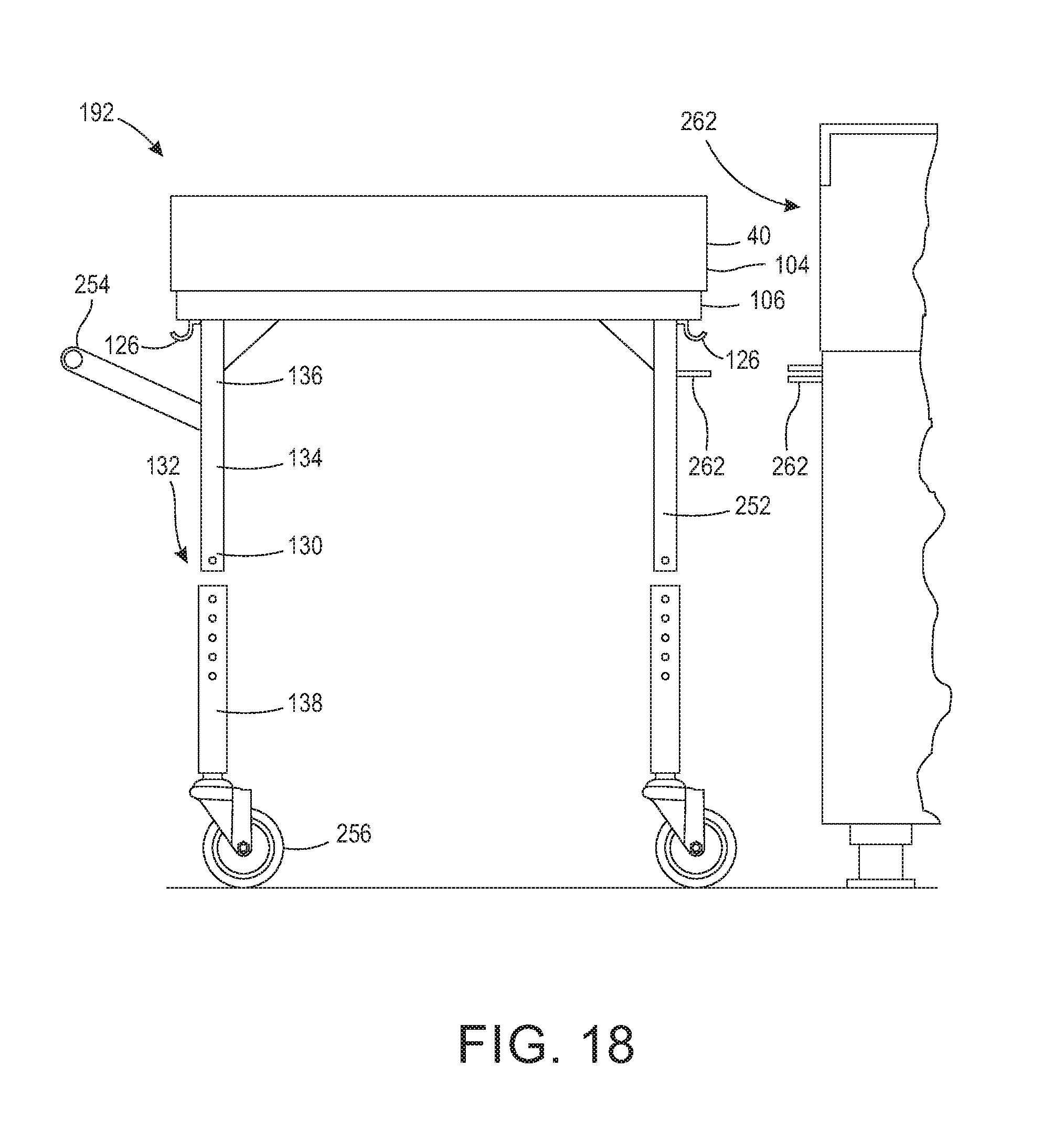
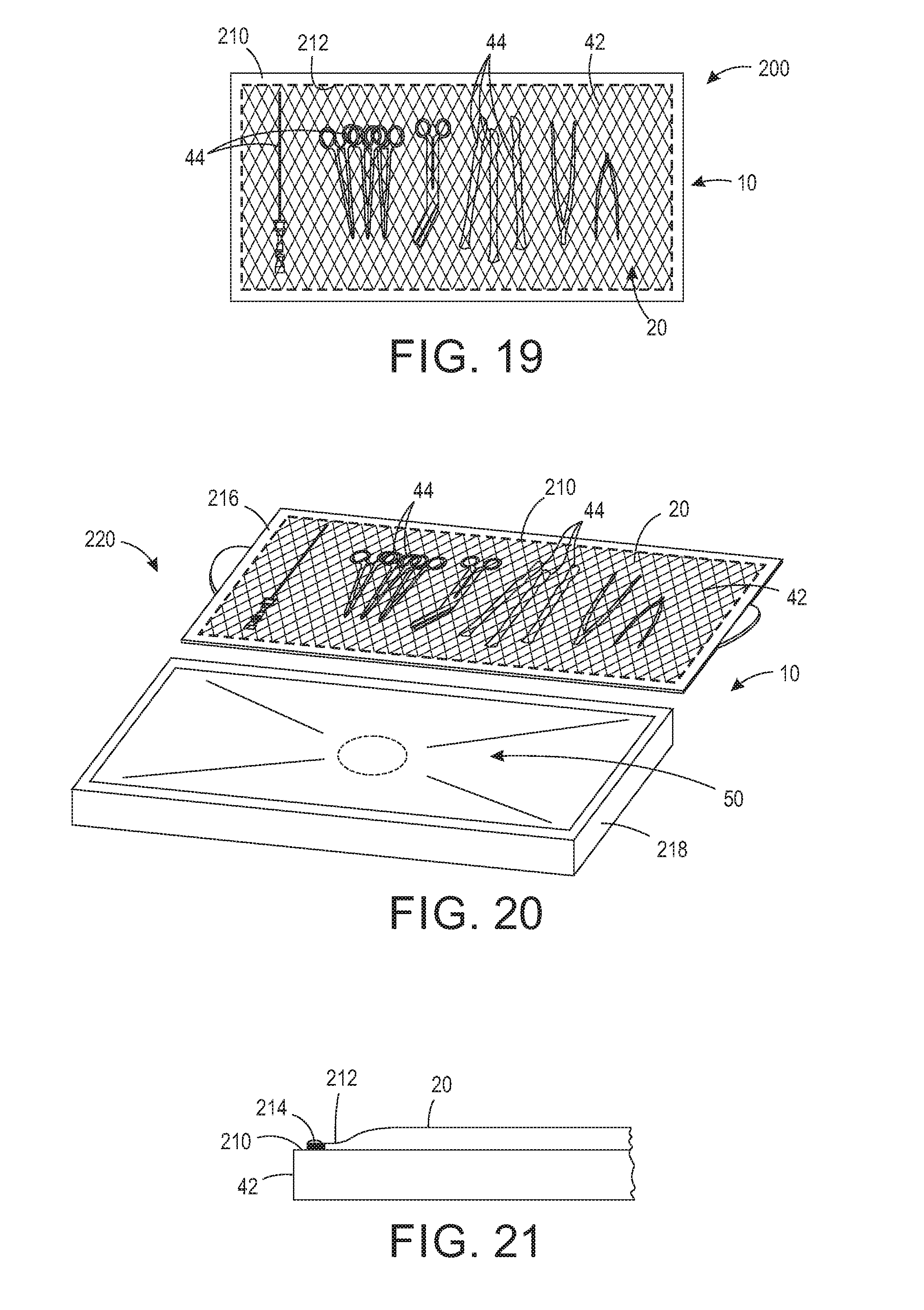
View All Diagrams
| United States Patent Application | 20190021806 |
| Kind Code | A1 |
| Turbett; Robert E. | January 24, 2019 |
STERILIZATION WRAP SYSTEM
Abstract
The present invention comprises a sterilizing wrap system comprising a base having a support surface and a first sealing surface spaced from the support surface, the support surface supports at least one object requiring sterilization. A wrap is sized to engage the first sealing surface of the base to define a volume encompassing the support surface and the spaced first sealing surface of the base. A first seal maintains a sealed interface between the wrap and the first sealing surface.
| Inventors: | Turbett; Robert E.; (Penfield, NY) | ||||||||||
| Applicant: |
|
||||||||||
|---|---|---|---|---|---|---|---|---|---|---|---|
| Family ID: | 65014463 | ||||||||||
| Appl. No.: | 16/040058 | ||||||||||
| Filed: | July 19, 2018 |
Related U.S. Patent Documents
| Application Number | Filing Date | Patent Number | ||
|---|---|---|---|---|
| 62534494 | Jul 19, 2017 | |||
| Current U.S. Class: | 1/1 |
| Current CPC Class: | A61B 2050/314 20160201; A61B 50/15 20160201; A61L 2/206 20130101; A61L 2/208 20130101; A61L 2202/23 20130101; A61B 46/40 20160201; A61B 50/36 20160201; A61B 50/33 20160201; A61L 2202/182 20130101; A61L 2202/24 20130101; A61L 2/08 20130101; A61L 2/26 20130101; A61B 46/10 20160201; A61L 2/14 20130101; A61B 50/13 20160201; A61L 2202/181 20130101; A61L 2/07 20130101 |
| International Class: | A61B 46/00 20060101 A61B046/00; A61B 50/33 20060101 A61B050/33; A61L 2/07 20060101 A61L002/07 |
Claims
1. A sterilizing wrap system comprising: a base having a support surface and a first sealing surface spaced from the support surface, the support surface for supporting at least one object requiring sterilization; a wrap sized to engage the first sealing surface of the base to define a volume encompassing the support surface and the spaced first sealing surface of the base; and a first seal for maintaining a sealed interface between the wrap and the first sealing surface.
2. The sterilizing wrap system of claim 1, wherein the first seal is a clamp, and wherein the first sealing surface of the base is a channel at least partially extending circumferentially around the base, wherein the channel is sized to receive the clamp.
3. The sterilizing wrap system of claim 1, wherein the base further comprises a second sealing surface spaced from the first sealing surface, and wherein the wrap includes a second seal for forming a sealed interface between the wrap and the second sealing surface.
4. The sterilizing wrap system of claim 1, wherein the wrap is a bag formed of a first material compatible with sterilizers, the bag having a flexible collar for expanding to dispose the wrap over the first sealing surface of the base in the install position and for applying tension to the first sealing surface of the base in the deployed position.
5. The sterilizing wrap system of claim 1, wherein the wrap includes a first portion of a first material having an area for encompassing at least the support surface, and a second portion of a second material having an area for encompassing at least the first sealing surface of the base, wherein the first material is a filter material and the second material is a flexible material.
6. The sterilizing wrap system of claim 5, wherein the second material forms the first seal, wherein the first seal is a clamp for maintaining the sealed interface between the wrap and the first sealing surface.
7. The sterilizing wrap system of claim 2, wherein the base is an operating room back table and wherein the base includes a skirt, the skirt having the channel for receiving the clamp.
8. The sterilizing wrap system of claim 1, wherein the support surface is a first portion of the base.
9. The sterilizing wrap system of claim 1, wherein the base further comprises wrap supports extending from the base, the wrap supports being at least one of collapsible and removeable.
10. The sterilizing wrap system of claim 8, wherein the first portion of the base is a tray for holding at least one of surgical instruments, or trays, racks, frames, or shelves arranged to hold instruments.
11. The sterilizing wrap system of claim 9 wherein the wrap supports include sidewalls and a top shelf spaced from the support surface of the base.
12. The sterilizing wrap system of claim 8, further comprising a frame operatively connected to the base, the frame having a plurality of struts forming front, back, top, and side portions, wherein each portion defines a hollow center portion.
13. The sterilizing wrap system of claim 12, wherein the frame is removeable from the tray.
14. The sterilizing wrap system of claim 1, wherein the support surface of the base is sloped.
15. The sterilizing wrap system of claim 1, wherein the support surface or at least one of the first and second sealing surfaces of the base includes a drain.
16. A method of packaging objects for sterilization comprising: (a) placing at least one object to be sterilized on a support surface of a base, the base having a first sealing surface; (b) deploying a wrap having a first portion for encompassing the support surface of the base and a second portion for confronting the first sealing surface of the base; and (c) clamping the second portion of the wrap to the first sealing surface of the base to form a sealed interface between the wrap and the first sealing surface in a deployed position.
17. The method of claim 16, further comprising the steps of: (a) transporting the base having the deployed wrap to a sterilizer; (b) transferring the base having the deployed wrap into the sterilizer; (c) performing a sterilization cycle in the sterilizer; (d) removing the base having the deployed wrap from the sterilizer; (e) transporting the base having the deployed wrap to the area of use; and (f) opening the deployed wrap to expose the at least one object sterilized in the sterilizer.
18. The method of claim 17, wherein the step of opening the wrap further comprises: (a) opening the first portion of the deployed wrap along a set of predetermined guidelines to form wrap segments having an outer surface and an inner sterilized surface; (b) folding the wrap segments over the first sealing surface exposing the inner sterilized surface.
19. The method of claim 17, wherein the step of transporting the base having the deployed wrap to the sterilizer further comprises: (a) loading the base having the deployed wrap onto a transfer cart, the transfer cart having a first end including a locking mechanism and a second end; (b) releaseably locking the base having the deployed wrap to the transfer cart; (c) positioning the first end of the transfer cart adjacent the sterilizer; (d) locking the first end of the transfer cart to the sterilizer with the locking mechanism and releasing the lock between the base having the deployed wrap and the transfer cart to enable the base having the deployed wrap to be transferred into the sterilizer.
20. A single-use wrap system for use in the sterilization of objects requiring sterilization, the system comprising: (a) a rigid base formed of a material adapted to withstand exposure to a sterilizing agent without degradation, the base having a support surface having a portion for retaining objects and a perimeter edge; (b) a wrap sized to overlap the support surface and having a perimeter edge corresponding with the perimeter edge of the support surface of the base; and (c) a seal disposed along the perimeter edges of the wrap and/or the base, the seal forming a sealed interface between the wrap and the base.
21. The single-use wrap system of claim 20, wherein the support surface is removeable from the base.
Description
BACKGROUND OF THE INVENTION
1. Field of the Invention
[0001] The present invention relates to a method and apparatus for sterilizing surgical instruments and the like and more particularly to a sterilizing wrap system comprising a base and a wrap.
2. Description of Related Art
[0002] Cleaning and sterilizing surgical instruments, laboratory supplies, and medical devices are important in many fields including, but not limited to, scientific research, veterinary medicine, and human medicine. Surgical instruments, for example, must be provided in a sterile condition to be able to be used in surgery. To reduce the risk of introducing harmful microorganisms to a patient or in scientific research, several steps are typically followed. First, the objects may be decontaminated and pre-cleaned. Next, the objects are cleaned, rinsed and dried. Following a thorough cleaning, the objects are sterilized. Sterilization is a term referring to any process that eliminates, removes, deactivates, or kills bacteria or other types of living microorganisms, including transmissible agents (such as fungi, bacteria, viruses, or spore forms) present on a surface, or contained in a fluid, or in medication, or in a compound such as biological culture media. Sterilization can be achieved by applying heat, steam, chemicals, such as using ethylene oxide (EO), irradiation, high pressure, and filtration or combinations thereof. In general, surgical instruments, laboratory supplies, and medical devices must be sterilized to a high sterility assurance level before use on a body. Examples of such instruments include scalpels, hypodermic needles, endoscopes, and implantable medical devices (IMD), such as artificial pacemakers.
[0003] A widely used method for heat sterilization is the autoclave, sometimes referred to as a converter. Autoclaves commonly use steam heated to 121-134.degree. C. To achieve a degree of sterility, a holding time of at least 15 minutes at 121.degree. C. at 100 kPA, or 3 minutes at 134.degree. C. at 100 kPa is required. Additional sterilizing time is usually required for liquids and instruments packed in layers of cloth, as they may take longer to reach the required temperature.
[0004] One method of sterilization involves passing steam through a rigid container system, for example, a cabinet. For effective sterilization, steam needs to penetrate a cabinet load uniformly. Accordingly, the cabinet must not be overcrowded, and the lids of bottles and containers must be left ajar. During the initial heating of the chamber, residual air must be removed. Indicators should be placed in the most difficult places for the steam to reach to ensure that steam actually penetrates there.
[0005] A filter is typically placed over the vent to keep particles or extraneous materials from entering the cabinet before, during or after the sterilizing process. Once the sterilizing process is completed the filter needs to be removed and inspected by medical professionals to verify the integrity of the sterilizing process was maintained. If it is discovered during inspection that the filter did not remain intact, the sterilizing process has to be repeated with a new filter.
[0006] Another method of sterilization involves wrapping instruments, supplies, medical devices, or trays containing such objects, with a packaging material to allow sterilization of the contents of the tray, and to maintain the sterility of the tray contents until the wrap is opened. Traditionally, instruments that need to be reprocessed are provided in vented trays, allowing the sterilizing agent to flow through the tray, and sterilizing all the surfaces. In order to maintain sterility after removal from the sterilizer, the trays are wrapped in a material that allows the sterilizing agent to pass through, but protecting the inner tray from microorganisms until use. A multitude of packaging materials can be used for sterilization, including woven fabrics, which may be made of cotton, a cotton-polyester blend, or synthetic blend, or nonwoven materials, which may be made of plastic polymers, cellulose fibers, or washed paper pulp bonded under pressure into sheets. Wrapping instruments, supplies, medical devices, or trays containing such objects, in packaging material, including but not limited to wraps sometimes results in the packaging material tearing or puncturing, in which case the sterilization process must be repeated with new packaging material. Single instruments can be individually sterilized in a peel pouch. The pouch maintains the sterility of the instrument after the sterilization process is complete by protecting it from the contaminants in the environment. Peel pouches, however, are not efficient as multiple tools cannot be sterilized within the same peel pouch. Further, peel pouches are to be loaded into a sterilizer on its size to promote air removal and penetration of the sterilant as well as to discourage moisture retention. Peel pouches cannot include implants having several component parts. These component parts would need to be packaged in separate peel pouches before sterilizing, typically by gamma irradiation processing.
[0007] Alternatively, the trays may be placed in a rigid container utilizing filters that act as the wrap does, allowing the sterilizing agent in, but blocking microorganisms afterwards. The filter also allows the escape of the sterilizing agent or its byproducts. Once the sterilizing process is complete the filter needs to be removed and inspected by medical professionals to verify the integrity of the sterilizing process was maintained. If it is discovered during inspection that the filter did not remain intact, the sterilizing process has to be repeated with a new filter. Large containers have been made to handle multiple trays to allow a consolidation of steps, simplifying the process. These large containers are expensive to manufacture, however, and bulky to store. Further, the large containers hold several instruments, which collectively, is a significant weight load, requiring particular lifting devices to load and unload the container into a sterilizer and to place the container in storage.
BRIEF SUMMARY OF THE INVENTION
[0008] The present invention includes a sterilizing wrap system for sterilization comprising a base having a support surface and a first sealing surface spaced from the support surface, the support surface for supporting at least one object requiring sterilization, a wrap sized to engage the first sealing surface of the base to define a volume encompassing the support surface and the spaced first sealing surface of the base, and a first seal for maintaining a sealed interface between the wrap and the first sealing surface.
[0009] The present invention further includes a sterilizing wrap system for sterilization. The sterilizing wrap system includes a base having a support surface for supporting at least one object requiring sterilization and a first sealing surface, and a wrap sized to at least partially encompass the base, the wrap having a first portion for encompassing the support surface of the base and a second portion for confronting the first sealing surface of the base, wherein the second portion is a flexible collar for expanding to dispose the wrap over the support surface of the base in the install position and for applying tension to the first sealing surface of the base in the deployed position.
[0010] Another configuration of the present invention provides a method of packaging objects for sterilization. The method includes placing at least one object to be sterilized on a support surface of a base, the base having a first sealing surface; deploying a wrap having a first portion for encompassing the support surface of the base and a second portion for confronting the first sealing surface of the base; and clamping the second portion of the wrap to the first sealing surface of the base to form a sealed interface between the wrap and the first sealing surface in a deployed position. The method may further include the step of applying a frame having vented areas before the step of deploying the wrap.
[0011] In a configuration, the method further includes the step of transporting the base having the deployed wrap to a sterilizer; transferring the base having the deployed wrap into the sterilizer; performing a sterilization cycle in the sterilizer; removing the base having the deployed wrap from the sterilizer; transporting the base having the deployed wrap to the area of use; and opening the deployed wrap to expose the at least one object sterilized in the sterilizer. Further, the step of transporting the base having the deployed wrap to the sterilizer may further include loading the base having the deployed wrap onto a transfer cart, the transfer cart having a first end including a locking mechanism and a second end; releaseably locking the base having the deployed wrap to the transfer cart; positioning the first end of the transfer cart adjacent the sterilizer; and locking the first end of the transfer cart to the sterilizer with the locking mechanism and releasing the lock between the base having the deployed wrap and the transfer cart to enable the base having the deployed wrap to be transferred into the sterilizer.
[0012] In yet another configuration, a single-use wrap system for use in the sterilization of objects requiring sterilization includes a rigid base formed of a material adapted to withstand exposure to a sterilizing agent without degradation, the base having a support surface having a portion for retaining objects and a perimeter edge; a wrap sized to overlap the support surface and having a perimeter edge corresponding with the perimeter edge of the support surface of the base; and a seal disposed along the perimeter edges of the wrap and/or the base, the seal forming a sealed interface between the wrap and the base. The support surface may be removeable from the base.
BRIEF DESCRIPTION OF THE SEVERAL VIEWS OF THE DRAWING(S)
[0013] FIG. 1 is a perspective view of an operating back room table.
[0014] FIG. 2 is a perspective view of a sterilizing wrap configured to encompass the operating room back table.
[0015] FIG. 3 is a cross-sectional view taken along lines 3-3 showing the sterilizing wrap disposed on the operating back room table and constructed of a first material and a second material.
[0016] FIG. 4 is a cross-sectional view showing the sterilizing wrap disposed on the operating back room table and constructed of a single material.
[0017] FIG. 5 is a perspective view of an exemplary embodiment of a continuous sterilizing wrap.
[0018] FIG. 6 is a perspective view of another exemplary embodiment of a segmented sterilizing wrap.
[0019] FIG. 7 is a perspective view of an exemplary embodiment of an operating back room table having extending sides.
[0020] FIG. 8 is a perspective view of an exemplary embodiment of a sterilizing wrap support.
[0021] FIG. 9 is a perspective view of an exemplary embodiment of an operating back room table having support sides and a top shelf
[0022] FIG. 10 is a perspective view of another exemplary embodiment of a sterilizing wrap system for sterilizing objects, the sterilizing wrap system having a base and a frame.
[0023] FIG. 11 is a perspective view of another exemplary embodiment of a sterilizing wrap system for sterilizing objects, the sterilizing wrap system having a base and a frame.
[0024] FIG. 12 is a perspective view of a sterilizing wrap configured to encapsulate the frame and base shown in FIG. 11.
[0025] FIG. 13 is a perspective view of another exemplary embodiment of a sterilizing wrap.
[0026] FIG. 14 is a perspective view of the sterilizing wrap sealed to an exemplary embodiment of the base.
[0027] FIG. 15 is a perspective view of the sterilizing wrap configured to encapsulate the table shown in FIG. 18
[0028] FIG. 16 is a perspective view of the sterilizing wrap configured to encapsulate a table having a pedestal.
[0029] FIG. 17 is perspective view of another sterilizing wrap of the present invention.
[0030] FIG. 18 is a side view of a table having detachable legs.
[0031] FIG. 19 is a top view of a base having a support surface for receiving objects requiring sterilization and a wrap sealed to a perimeter edge of the support surface.
[0032] FIG. 20 is a perspective view of a base having a removeable support surface for receiving objects requiring sterilization and a wrap sealed to a perimeter edge of the support surface.
[0033] FIG. 21 is a cross-sectional view of a base having a wrap sealed to the support surface.
[0034] FIG. 22 is a flow chart disclosing the method steps of packaging objects for sterilization.
DETAILED DESCRIPTION OF THE INVENTION
[0035] It should be appreciated that the same reference numbers appearing in different figures identify the same structural elements of the present invention. While the description of the present invention includes what is currently considered to be the preferred configurations, it should be appreciated that the present invention is not limited to such configurations. Moreover, it should be appreciated that the present invention is not limited to the particular methodology, materials and modifications described herein and that the terminology used herein is not intended to limit the scope of the present invention. The scope of the present invention is therefore to be determined solely by the appended claims.
[0036] The invention pertains to a sterilizing wrap system to provide significant vent to volume ratios for purposes of sterilizing instruments, medical devices, and the like during sterilization in a sterilizer. The term sterilizer includes, but is not limited to, a housing or device defining an interior retaining the sterilization system and in which a controlled environment is create to impart a desired sterilization. Sterilizers include autoclaves; hot air ovens; ethylene oxide; low temperature steam and formaldehyde; sporicidal chemicals; irradiation; chlorine dioxide (CD) gas sterilization; hydrogen peroxide; vaporized hydrogen peroxide; hydrogen peroxide plasma; electron beam and gas plasma devices.
[0037] The system provides the benefits of both wrapping techniques and rigid container systems. By utilizing a base as a rigid component without a door, one or more instruments and/or trays may be placed on it. By utilizing a wrap as a protective cover, significant vent to volume effects can be realized. This results in a shorter time required for the sterilizing agent or its byproducts to be vented. Further, when a base, such as an operating room back table, is used, there is no need to transfer the instruments from a rigid container or tray onto a back table for use in the operating room, as the back table is integral to the sterilizing wrap system and thus, the instruments are already organized on the table and presentable after sterilization. By "operating room back table" or "back table" it is meant to generally refer to a table used in the operating room for holding surgical instruments. The operating room back table is sometimes known as an instrument table or a work table. The back table can be made of stainless steel, plastic, or other rigid materials, and can be any shape or size. Typically, the back table is a rectangular shaped table having legs and/or a pedestal which may or may not be adjustable and/or removable.
[0038] Generally, the sterilizing wrap system 100 includes a base 10 providing a support surface and a wrap 20 providing a protective cover. The base 10 may be any shape and size for providing a support surface. For example, although base 10 is shown in a rectangular configuration, the base 10 may be any shape, including, but not limited to, circular, oval, square, and elliptical. The base 10 in this configuration is rigid and may be a tray, table, sheet, plate, or any other type of rigid, supportive base. It should be appreciated that the sterilization wrap 20 may take many different shapes and forms, including but not limited to a sheet, bag, pouch, and a partially formed bag. Referring now to the figures, FIG. 1 is a perspective view of one configuration of a base 10 and FIG. 2 is a perspective view of one configuration of a wrap 20. As shown in FIG. 1, the sterilizing wrap system 100 includes base 10, which in one configuration may be an operation room back table 40 having a support surface 42 for supporting at least one object 44 requiring sterilization by a sterilizer. Objects 44 requiring sterilization may include, but are not limited to surgical tools and instruments, implants, laboratory supplies, and medical devices. In one configuration, the base 10 includes a dependent skirt 46 and may be detachable from legs 48 or a pedestal (not shown). The base 10 may also include a flange or sidewalls (not shown) along the perimeter edge of the support surface 42 for retaining the objects 44 on the support surface 42, especially during transportation when objects may otherwise shift. Alternatively, or additionally, the base 10 may include dividers, shelves, or sectioned portions for maintaining objects 44, including but not limited to, surgical instruments and/or trays, on particular sections of the base 10. The base 10 may further include additional fasteners, including but not limited to Velcro, magnets, and the like to releaseably hold the objects 44 in place. The base 10 may include a laser outline of at least some objects 44 identifying a preferred location for particular objects. Other features for organizing and maintaining objects 44 on the base 10 are intended to be included within the scope of the invention as claimed.
[0039] In some configurations, the base 10 may include a drain system 50 for draining sterilizing agent and/or liquid condensate formed during the sterilization process. The base 10 may include, for example, a sloped surface 52, for example, as shown in FIGS. 1 and 11, to direct drainage to a predetermined area. The sloped surface 52 may be of any slope and may be a straight line (angular) or curved. In one configuration the base 10 includes at least one drainage well having a downwardly sloping surface 52 arrange to direct condensate to a drain aperture 54. In one configuration, the drain aperture 54 is approximately 0.5 to 5 inches in diameter. In another configuration, the drain aperture 54 is approximately 2-3 inches in diameter. The drain aperture 54 may be any shape and size that allows liquid condensate or liquid sterilant to drain from the surface of the base 10. The surface 52 may be frusto-conical shaped to further direct sterilizing agent and condensate to the drain aperture 54. Alternatively, the drain system 50 may include a continuous decline directing sterilizing agent and/or liquid condensate to a drain well or aperture 52 located proximate one side of the base 10. It should be appreciated that the drain well or aperture 54 or a plurality of drain wells and/or apertures 52 may be positioned anywhere on the floor of the base, with the floor configured to permit drainage thereto. In yet another configuration, the drain system 50 may include a sloped surface or decline without a drain well or aperture 52, which directs sterilizing agent and/or liquid condensate to an edge of the floor of the base 10. The drain system 50 many include a filter or filters within the aperture. It should be appreciated by those having ordinary skill in the art that other drainage systems that allow for sterilizing agent and/or liquid condensate to drain from the floor of the base 10 are possible and these modifications are intended to be included within the scope of the claims. The base 10 may further include a holder to maintain the objects 44 above the drain system 50. The holder may be, for example, a plate having perforations, apertures, or wells, or a tray configured to be suspended above the base 10, among other things. The holder may be integral to the base 10 or removeable from the base 10. It should be appreciated that there are many configurations known in the art to hold instruments above a drain system and these configurations are intended to be included within the spirit and scope of the claims.
[0040] As shown in FIGS. 3 and 4, the base 10 further includes a sealing surface 60 for the wrap 20 to seal thereto. In one configuration, the sealing surface 60 is a lower outer wall 62 extending from a perimeter edge of the support surface 42. In another configuration, the sealing surface 60 is an upper outer wall extending above the perimeter edge the support surface 42. Typically, base 10 is comprised of stainless steel, and thus the sealing surface 60 is typically stainless steel. It should be appreciated, however, that base 10 may be comprised of other types of materials that can withstand exposure to a sterilizing agent without degradation, and thus the sealing surface 60 is not limited to such material. The base 10 may further include, or alternatively include, additional sealing surfaces, for example, sealing surface 70. In one configuration, the sealing surface 70 may include a channel 76, as shown in FIGS. 10 and 11, which channel 76 at least partially circumscribes the sealing surface 70 as described infra. In one configuration, the channel 76 circumscribes the entire perimeter of the base 10. It should be appreciated that the base 10 may have additional or alternative sealing surfaces for forming a sealed interface with the sterilizing wrap 20.
[0041] The sterilization wrap 20 may comprise many various shapes and styles and may be applied over the support surface 42 of the base 10 or from under the support surface 42 of the base 10. As shown in FIGS. 2, the sterilization wrap 20 may include portion 80 for encompassing at least the support surface 42 and a portion 82 having an area for encompassing the at least the sealing surface 60 and/or 46 of the base 10. In one configuration, the wrap 20 is comprised of a material that is resistant to tears. The sterilization wrap 20 may be a single layer or multi-layer material. The material may be made with spunbound, meltblow, spunbound laminate (SMS) fabric, polypropylene, Tyvek, or any other type of material that provides a filtration capability. The materials may alternatively be one that can withstand gamma radiation. For example, the material may comprise a material that is gas-impermeable and which provides a strong and durable sterile barrier. In yet another configuration, the material is gas and water vapor permeable but not permeable by liquid. In this configuration, the material allows air and steam to pass through, but not by liquid droplets.
[0042] The wrap 20 material is selected based on the desired filtering and the type of sterilization process used. For example, a Tyvek and plastic combination would not be used in a steam sterilization process as it would melt. However, Tyvek and plastic combinations can be used in ethylene oxide (EtO) sterilizers. A filtering material can be used when steam must penetrate the material. In some configurations, the sterilization wrap 20 is a single-use material, and in other configurations, the sterilization wrap 20 is reusable. Further, the sterilization wrap 20 may include a single type of material or be constructed of multiple materials. As shown in FIG. 3, in one configuration, portion 80 is comprised of a filtering material and portion 82 is comprised of a stretchable material capable of forming an integral flexible collar 84. The flexible collar 84 may be coupled to portion 80 by ultrasonic welding, adhesive, tape, or by other manufacturing methods known in the art. In one configuration, the flexible collar 84 is made of shrink wrap that will shrink during the sterilization process to form a seal around base 10. In another configuration, the flexible collar 84 is made of non-latex, stretchable material, such as Kraton.TM. from Kraton Corporation available at http://www.kraton.com/products/medical/fabrics.php.
[0043] Also, the wrap 20 may be used as a protective drape as traditionally used in the operating room. Thus, the wrap 20 may be applied to the operating base 10 having objects for sterilization, wherein portion 82 is sealed to the sealing surface 60 and/or 46 of the base 10, the base 10 placed into the sterilizer and sterilized, and then transported to the operating room. The sterilized objects 44 can be accessed by opening the wrap 20 in a manner that permits the wrap to drape down from the sealing surface 60 of the base 10, such that the sterilized objects 44 are then presented to the user. The wrap 20 thus, serves as a drape in the operating room or other sterilized environment. The drape may be solid or made up of segments. The segments may be of the same material, or varied, including, but not limited to, thicker material or clear portions. In o
References
D00000

D00001

D00002

D00003

D00004

D00005

D00006

D00007

D00008

D00009

D00010

D00011

D00012
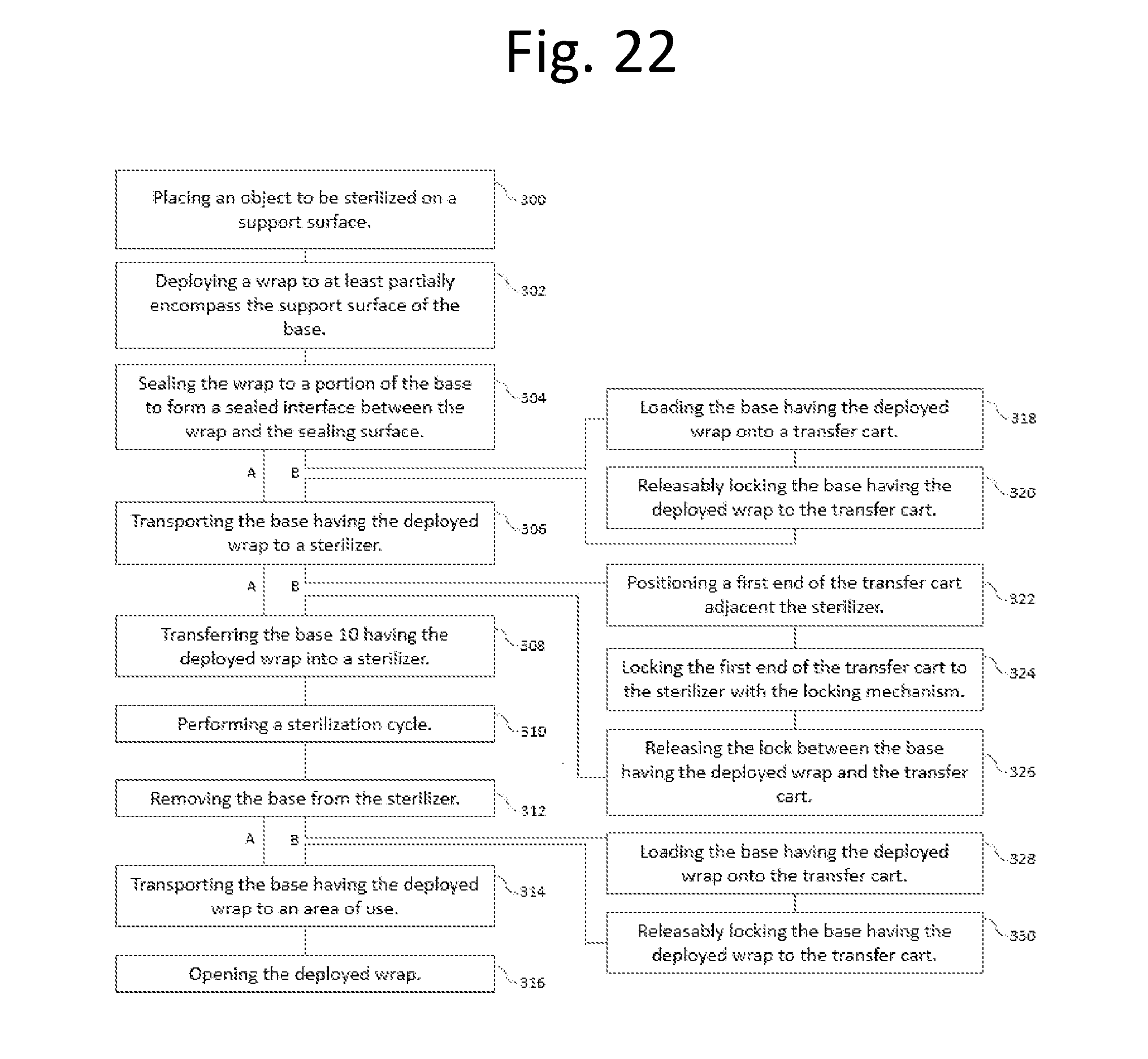
XML
uspto.report is an independent third-party trademark research tool that is not affiliated, endorsed, or sponsored by the United States Patent and Trademark Office (USPTO) or any other governmental organization. The information provided by uspto.report is based on publicly available data at the time of writing and is intended for informational purposes only.
While we strive to provide accurate and up-to-date information, we do not guarantee the accuracy, completeness, reliability, or suitability of the information displayed on this site. The use of this site is at your own risk. Any reliance you place on such information is therefore strictly at your own risk.
All official trademark data, including owner information, should be verified by visiting the official USPTO website at www.uspto.gov. This site is not intended to replace professional legal advice and should not be used as a substitute for consulting with a legal professional who is knowledgeable about trademark law.